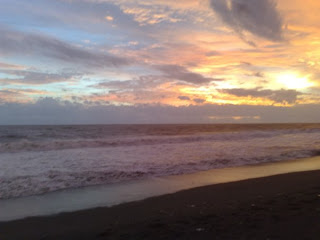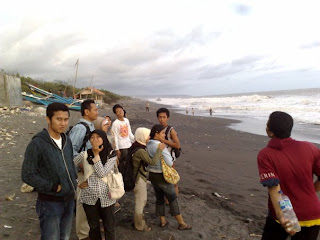Glagah Beach, from Lagoon Scenery to Agro Tourism
A coastal plain of the field will soon be greeted when visiting Glagah Beach. Spaciousness of this coastal plain to give you the opportunity to spread his views to all directions. Looking straight ahead, you can see the horizon very long ocean and the sky. While the beauty of the bend of the coastline will pamper the eyes when their eyes to the west or east.
Coastal plains of the field and a long coastline also gives you a number of alternative locations to see the beauty of the beach. Each location has a different feel as though they are located in one area. At each location, you can enjoy all the beauty of the beach with ease, there is absolutely no giant rocks which sometimes prevents eye.
The first location is very appropriate to view overlooking the beach is a location that will be the port the next few years. You can find the place when the first branch of the postal charges, the sign is a signpost that read PP. Meeting streams and the ocean waves can be seen full harmony with the view up there is a substation there.
Throughout the first location to a few hundred meters to the west, you can find a lagoon with a water flow toward the river mouth. Laguna beach is divided into two areas, locations that are still covered by some beach plants and grasses and sand dune area that directly borders the ocean. You can cross to the sand dune area through a connecting bridge which is located not far from the river mouth.
Walking further to the west, you can see the activities of local people and some people fishing. They are standing in line, along the coastal line holding their fishing rods. Sloping beach area that gives grace enough fish in large numbers. A number of stalls offering seafood there too, serving a variety of menus that are worth trying.
Besides the beautiful beach scenery, Glagah Beach also has a variety of coastal tourism facilities. One is the motor cross area which is located right on the beach with an area large enough, to give satisfaction for those of you fans of this sport. Meanwhile, the asphalted road that connects Glagah beach with other beaches can be used as an arena of sport bike.
You can even enjoy the beach facilities with visiting plantations agro Wanadri Kusumo. There, you can observe the cultivation process of elixir, such as dragon fruit and flowers Roselle. In addition, you can also hire gethek, canoeing and rowing duck that could be used for tours of the lagoon or just cross over the wooden bridge towards the sand dune area on the beach.
Tired of traveling, you can rest in the huts in the area of plantation lesehan Wanadri Kusumo. A number of exotic food and drink menu are worth trying. You can taste the fresh dragon fruit juice and is known to cure various diseases, or order Roselle flower syrup that will quench your thirst and neutralize various toxins in the body.
To enjoy the whole panoramic view Glagah beach, you can go across the two alternative roads. First, walk through the streets of Bantul, south and turn right into the path of Bantul - Purworejo after arriving in Palbapang. Second, walking west past the trajectory path of Yogyakarta - Wates - Purworejo and turn left after the signpost to find Glagah Beach. You can use a personal vehicle for easier access.
Travel to the beach is not as difficult as the way to beaches in Gunung Kidul. The roads are impassable and there was not much inclined flat so you can climb and he will teach her to relax. Trajectory toward the town of Purworejo it also connects Glagah with other beaches in Kulon Progo Regency. So, once a row, two of the three islands are exceeded, you can visit other beaches afterwards.










